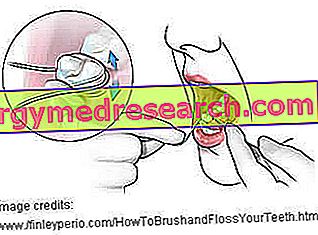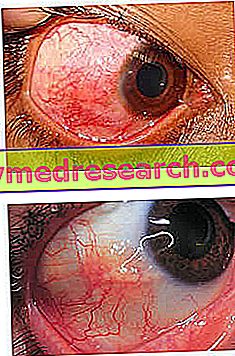What is dental floss?
In the battle against caries and tooth infections, proper use of dental floss undoubtedly helps to preserve the full health of the teeth, deeply removing food debris and the sticky layer of plaque wedged between the various dental elements.

When to use dental floss?
That floss should be used at least once a day and preferably in the evening is now known. What still raises some doubts is when to use it. In this regard, the thought of experts is divided into two:
- Some authors recommend passing the thread between the teeth before brushing with toothbrush and toothpaste: the wire, removing plaque and food residues nested between the teeth, allows the active ingredients of the toothpaste (eg fluorine or bleaching agents) to reach even the interdental fissures.
- Other specialists suggest using the wire only after brushing the teeth: in doing so, starting from the assumption that the toothbrush has already removed a certain quantity of dirt, the action of the floss is facilitated.
However, what really matters is not so much the use of dental floss before or after cleaning with a toothbrush, but rather an adequate method of use and constant use of the floss. So let's see how to use dental floss correctly.
Mode of use
To show off an enviable smile and healthy and strong teeth, it is important - and indispensable - to dedicate several minutes of your time to cleaning your teeth every day, several times a day. If the toothbrush should be used at least three times a day and immediately after meals, flossing can be passed between the teeth just once or twice a day.
- It is good to repeat it once again: what is important is to use the wire regularly in an adequate manner.
The following are the main rules for a flawless use of dental floss:
- Cut a segment of dental floss (with the help of a special file inserted into the spool container) 30-40 cm long
- Wrap both ends of the floss around the middle finger (two turns recommended), grasping the stretched thread with thumbs and index fingers
- Gently press the thread on the thin interdental slit, taking care to keep it tight and firm
- Next, hug the tooth with the wire forming a sort of C. Slide the wire down (towards the end of the tooth crown), always giving some friction to clean the tooth even below the gum margin. By doing this, the floss acts like a blade, "cutting" and removing plaque.
The movement must be firm but at the same time delicate to avoid damaging or irritating the gum. We also remind you that there are two surfaces to be cleaned every time the wire is inserted into an interdental space; therefore, it is necessary to pass the thread in both parts.
- Whenever the wire is removed to clean the next tooth, it is essential to use a clean part of the tape.
- Repeat the procedure in all teeth. It is suggested to start flossing from the posterior teeth, ending with the molars of the opposite side.
- The posterior teeth (first and second molars and, if present, wisdom teeth) can cause some difficulty during hygiene with dental floss. If the cleaning was particularly complicated due, for example, to dental crowding or crooked teeth, it is possible to resort to the use of different instruments - such as the thread-tensioning forks or the vibrating dental floss - which make it easier to maneuver.
After cleaning all the teeth with dental floss, it is suggested to rinse the mouth thoroughly with the mouthwash, better if enriched with fluoride. The mouthwash, in addition to refreshing the mouth, improving the breath and strengthening the tooth enamel, promotes the elimination of plate or food fragments removed with the wire.
Watch the video
X Watch the video on youtubeInadequate use
Inadequate use or non-use of dental floss can put dental health at risk. The above seems to be still underestimated: the use of this very important tool for dental hygiene does not seem to be part of the Italian habits. So let's try to promote the use of dental floss, writing down the risks and complications that you might face if you don't use this effective dental facility.
First of all, failure to use dental floss encourages plaque stagnation in spaces that are inaccessible to the manual toothbrush; over time, plaque deposits evolve, becoming real calculus deposits that can only be removed by professional dental cleaning. Let us remember briefly that plaque and tartar, by retaining numerous germs of the oral bacterial flora, predispose enormously to the risk of dental infections, first of all caries. Do not forget, however, that the plaque not removed with a brush and floss is also responsible for bad breath, gingivitis and bleeding gums.
Inadequate cleaning of the oral cavity → plaque deposit → tartar formation → dental infections: caries, pulpits, abscess, cysts, granuloma, etc.
An inadequate use of floss, especially if hasty, is equally imprudent not only because the dirt trapped between the teeth is not effectively removed, but also because there is a risk of inflaming or traumatizing the gums.
The dental floss that is repeatedly broken in a certain point is an alarm bell, a probable indication of caries, accumulation of tartar or an uneven filling (overflowing)
Indications and contraindications
To obtain an effective response, it is advisable to start using dental floss no earlier than 10 years, or in any case after the milk teeth have fallen out and replaced with the permanent ones.
Regular use of dental floss is a recommended dental practice for virtually everyone, except for those patients who have particular dental anatomical impediments. For example, the use of traditional wire is not indicated in the presence of particularly narrow interdental spaces: in similar situations, excessive pressure on the wire could traumatize the gums, causing injury or small wounds. In this case, it is recommended to use a particularly delicate dental thread (eg gum massagers).
Furthermore, the use of dental floss is not recommended in the period immediately following the extraction of a tooth: in the first 5-7 days following the surgery, in fact, the area where the tooth was removed is particularly sensitive, swollen and painful ; therefore, we do not recommend using dental floss to remove dirt in the teeth near the extraction point.



